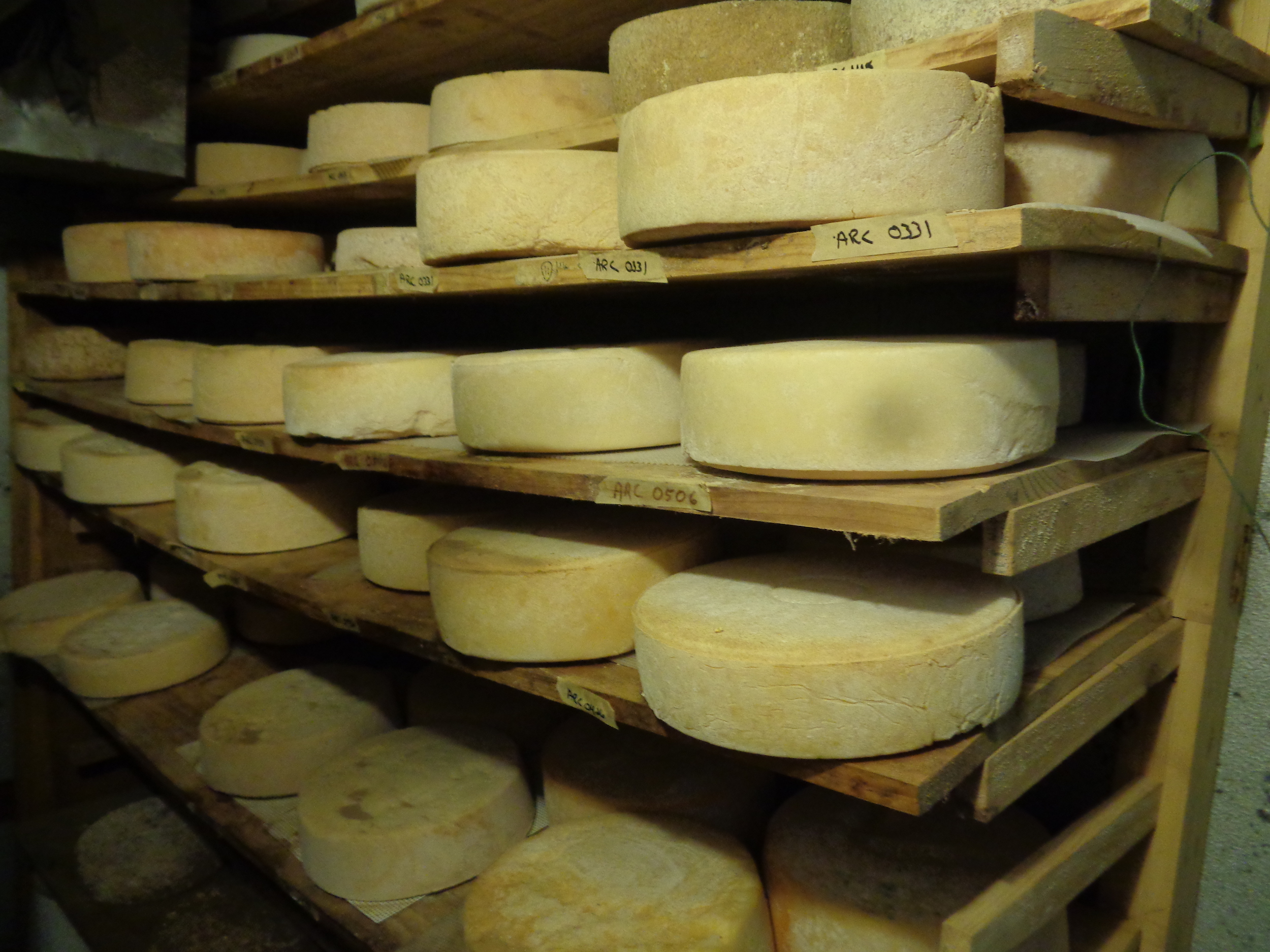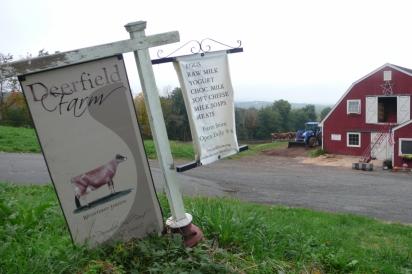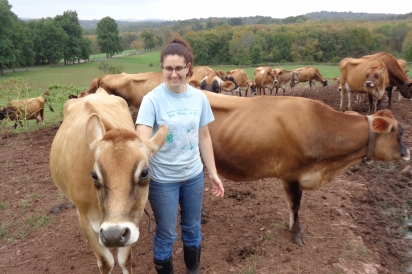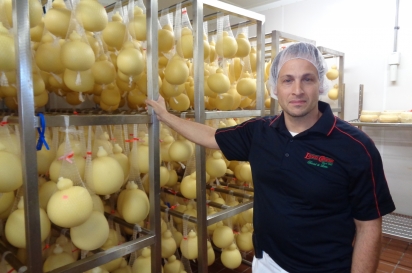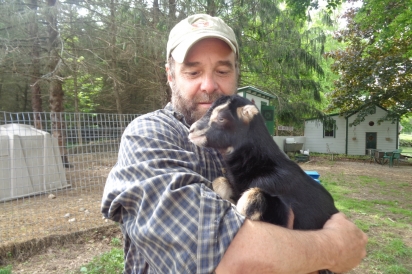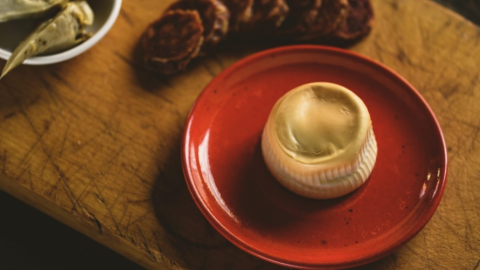Cheese: A Way of Life
Say, “CHEESE!” Just the sound of it makes us smile. Connecticut has it all: cheese from cows, goats, sheep, and even cheese made from buffalo milk (at both Liuzzi Cheese in Hamden and Calabro Cheese Corporation in East Haven). In fact, cheese is made in almost all parts of the state. Connecticut cheesemakers have a substantial list of cheeses in their repertoire, which, depending on the manufactory, range from raw to pasteurized, from soft (fresh) to hard (aged). However, getting artisanal cheeses from farm to cheese board is a surprisingly involved process that, ultimately, depends on the great passion that Connecticut’s dairy farmers bring to their craft. Cheesemaking, it turns out, is very hard work, indeed.
Dairy farming is not a job, it is a way of life. At work by dawn, dairy farmers must care for their animals seven days a week, maintain their twice-a-day milking schedule, and see that the feed (like corn, hay, or alfalfa) is properly grown and harvested, all to make cheese under tightly regulated conditions in which time is critical in order to keep ingredients fresh. There’s no time to relax, when long lines of cows and goats are waiting their turn to be milked, or when a pregnant cow gives birth in the middle of the night, in the pouring rain. While this can be a difficult life for a farmer, it is often a satisfying one. “I love the hands-on nature of cheesemaking,” says Mark Gillman of Cato Corner Farm in Colchester. “We begin each day with fresh raw milk; by the end of the day, we have transformed that milk into wheels of young cheese we can hold in our hands and feel what we’ve accomplished.
Cheesemaking begins with fresh milk from healthy, happy cows. That milk is used either raw or pasteurized (heated to 145°F or more for 30 minutes). Then cheesemakers add live cultures and rennet (enzymes that curdle milk) to begin the varied techniques and recipes that differentiate the cheeses as we know them. According to Mark Gillman, “each cheese recipe is different in terms of the size of the curd, the temperature we heat to, the amount of moisture we retain, and the rate at which acid develops during cheesemaking.” Recipes for hard cheese call for at least two months of aging. As Gillman explains, “essentially, when you make aged cheese, you are concentrating fat, protein, and minerals from milk into the cheese curd and getting rid of most of the moisture. Add a little salt to these curds, and you have a food that can last months or years.” According to Yale University Executive Chef Chris Molyneux, as cheeses age, the moisture evaporates, and the cheese begins to crystallize, turning “sharper and pungent.” Those enzymes and cultures, Gillman says, “create different microbiological environments [that] break down protein and fat in different ways during aging, leading to a wide variety of cheese styles and flavors
These artisanal cheeses bear the unique stamp of the connection cheesemakers have to their land. Once used primarily by wine connoisseurs, the term “terroir” aptly applies to cheesemaking. Each cheese has unique qualities of taste and feel derived from the land itself, in the same way that differences in soil, climate, and terrain change the flavor profile of wine grapes. Where the dairy animals live, the air they breathe, and the earth their food grows in all contribute to the terroir that identifies the cheese. There are also seasonal variations in milk, with richer cheeses typically produced in winter. Chef Molyneux confirms that he is able to taste distinctions in cheeses from different parts of Connecticut. He prefers the taste of the mild, soft cheeses made in areas along the Connecticut coast, because of the salinity in the ocean winds and in the brackish ground water, affecting the growth and taste of livestock feed. By contrast, in the hills of Litchfield County, cheeses from Arethusa Farm taste “more floral,” according to Chef Molyneux, reflecting the dense vegetation in that part of the state. He believes that Arethusa Farm cheeses surpass most Vermont cheeses in flavor, perhaps due to Connecticut’s longer growing season.
Cheese is big business in our small state of Connecticut. For instance, Elm City Cheese is a family-run business founded in New Haven in 1896 that now makes grated cheese in Hamden for sale, nationwide. Another family-run business, Liuzzi Cheese, begins operations at 3:00am, so its roughly 65 employees in Hamden can make 5,000 pounds or more of cheese each day, sending about 2,000 pounds a week just of its Caciocavallo cheese to its retail store in North Haven (Liuzzi Gourmet Food Market), as well as out of state. According to Jason Bowsza, spokesperson for the Connecticut Department of Agriculture (DoAg), in a recent count, at least 15 of the 22 entities in Connecticut that hold a license to manufacture cheese use milk from their own animals. Other producers make cheese by purchasing milk from neighboring farms or from sources, such as Agri-Mark, a dairy farming cooperative that uses regionally sourced milk. Agri-Mark boasts four cheese manufactories that include the Cabot and McCadam cheese plants (in Vermont and New York, respectively). Some Connecticut dairy farms, such as Sweet Grass Creamery of Preston, sell their milk to the Dairy Farmers of America Cooperative, which makes Borden cheese and other dairy products. Connecticut cheesemakers even sell internationally, such as Sankow’s Beaver Brook Farm in Lyme, which, at 175 acres, is rather large for Connecticut but small in comparison with other farms across the country
As with any agricultural trade, cheesemaking is a fragile industry that can be influenced by everything from weather to political policy. Getting a fair price for their products is increasingly difficult for cheesemakers, given that the price of milk has been dropping for more than four years, including a sharp plummet due to new tariffs in 2018 on international trade. As milk prices fall, other costs may rise, such as electricity, grain for animals, or rental fees on leased land. Extreme weather patterns can also disrupt dairy farms. Too much rain can promote the growth of bacteria, damaging feed crops, whereas drought means crops will not grow properly, making less on-site food available for livestock.
Despite these hardships, Connecticut dairy farmers take great pride in being good stewards of the land, preserving agriculture for future generations. For instance, four generations have worked the land at the Mattern Farm in Preston, since 1898. Its Sweet Grass Creamery took years to establish and finally opened just last year, offering cheese made from the milk of its own cows. Committed to sound environmental practices, Carol Wojtkun of Sweet Grass Creamery explains how they work with a nutritionist and “use rotational grazing to ensure that [the] cows have quality pastures to feed on throughout the grazing season.” Another cheesemaking farm, Sweet Pea Farm of North Granby, boasts eight generations of farmers from the Hayes family, dating back to the 1820s. Liuzzi Cheese traces its five generations of cheesemakers back to southern Italy. Deerfield Farm in Durham also grew out of a farming family. Deerfield makes a ricotta cheese and several varieties of “Brianna” soft cheese, so named after the first cow which owner Melynda Naples had when she was a small child. As with most of these farms, the farm animals have individual names and personalities and are treated according to their particular preferences. They leave a lasting impression, like Brianna did, and reinforce the farmers’ devotion both to them and the land on which they graze.
After so many of Connecticut’s historic farms and orchards were lost to subdivision development in recent decades, it is now a veritable badge of honor to put farmland into the Connecticut Farmland Preservation Program. Thankfully, such measures protect our state’s agricultural heritage by giving rights of development to the Connecticut DoAg, so that the land is used only for agricultural purposes, in perpetuity. Additionally, many cheesemakers offer educational opportunities for the public, promoting public interest in land preservation. Paul Trubey of Beltane Farm in Lebanon, along with his partner, Mark Pearsall, were Connecticut’s first licensed commercial goat cheese (chèvre) makers, now offering cheesemaking classes and lessons in raising goats, as well as the sale of baby goats in the spring. Jason Sobocinski (one of the founders of Caseus in New Haven, newly reopened as Olmo), has plans with his mother to use cheese as a means to teach teamwork in the workplace, through classes that pair cheese with sweets, wine, or beer. Another Sobocinski enterprise, Mystic Cheese Company in Groton, is under renovation and is installing a cheese cave for aging with a window for public viewing. Sweet Grass Creamery offers tours and the chance for the public to learn its production methods. With an educational component tied to its lease from the town of Durham, Deerfield Farm works with 4-H groups and school groups of all ages, and has hosted college students from Wesleyan, Yale, and Middlesex Community College's Veterinary Technician program. Focused on agricultural practices from its inception, the University of Connecticut now teaches about and makes its own cheese, which it has for sale in its Dairy Bar in Storrs
Culinary tourism offers a great way to learn about and support Connecticut cheesemakers. Several versions of a “Connecticut Cheese Trail” partner in tandem with the much-publicized Connecticut Wine Trail. Existing sketches of the cheese trail generally resemble a rectangle marked with farms in the middle of the state, with cheesemakers clustered close to the Massachusetts border in north-central Connecticut (such as in North Granby, Preston, and Enfield), running east to Colchester, Lebanon, and Brooklyn, then dropping down along the coast to Groton, East Haven, and Hamden, before finally heading north through Durham to reconnect with the northern cluster. This writer would add a “handle” to the Connecticut Cheese Trail, forming the outline of the Big Dipper, extending from the core rectangle, out to the northwestern part of the state, including Litchfield, Bantam (Arethusa Farm), Bethlehem (The Abbey of Regina Laudis), and up to Norfolk (Lost Ruby Farm). There are many more farms and locations to include, as well, too numerous for this article. Vineyards and meat producers inhabit many of these Connecticut cheese areas, offering delicate pairings for tasting along a complex culinary trail.
Please consult the Connecticut DoAg website for a partial list of cheesemakers in Connecticut and where to buy Connecticut-made agricultural products: CT.gov/doag.


